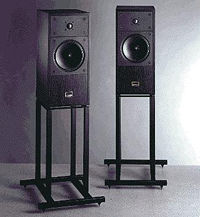This is without a doubt the best new product of 2014 for real-world audiophiles, and one of the most intriguing loudspeakers I’ve heard in a long time. It’s unique in that it’s inexpensive (£900) but produces a sound quality that far exceeds the price. Indeed, the Aeromax 6 appears to me to be a low-cost high-end design rather than just another bloated budget box.
It uses a Balanced Mode Radiator (BMR) instead of a traditional tweeter and midrange driver, which makes it almost unique. This is both radical and brilliant; it provides far improved dispersion, is more linear, and has lower distortion. The Aeromax’s 46mm BMR stretches from the high treble to the upper bass, obviating the need for a crossover right in the ‘presence’ zone, where it is least required. The human ear is most sensitive here, and the lack of a crossover eliminates phase difficulties in the midband, giving it an eerily electrostatic-like sound in certain ways. Because it’s made of light but firm paper, it’s also tonally incredibly smooth.
The BMR’s ability to go all the way down to 250Hz (many conventional tweeters struggle to go below 2kHz) allows the bass driver to focus on what it does best: creating massive amounts of clean low frequency energy. Two 165mm pulp bass drivers are employed in the Aeromax 6 to generate a gutsy, powerful sound; they work well with the BMR and produce a shockingly seamless and tuneful bass.
The original Aero 6 was released in 2012, but the London-based business opted to update it only eighteen months later. I was blown away by the overall tonal evenness and stereo imaging ability of the first iteration, but dissatisfied by the bass grip and treble extension. Designer Dominic Baker has addressed these difficulties in the new Aeromax series, and the result is that the large (344x980x240mm, 17kg) cabinets are now better supported and come in a stunning gloss white or black finish. Along with stronger OFC internal wiring and enhanced speaker terminals, the latest fourth generation Balanced Mode Radiator (BMR) is installed.
The Aeromax 6’s basic sound is extremely smooth yet naturally musical, setting it apart from virtually any other loudspeaker in its price range. It is completely free of the peaks and lumpiness in the midband that plague all but the greatest boxes. It’s truly strange, and the new Aeromax’s modifications make it even more so. The treble is still delicate and elegant, but it’s now more stretched, and the bass is more tight and tuneful. Any new buyer must decide whether or not to use the included foam bung in the front-firing bass port; my advice is to keep it in at all times because it tightens up what is still a slightly soft bottom end.
The Aeromax 6 creates a cathedral-like soundstage that is virtually holographic. This speaker never yells throughout the midband, making it extremely peaceful to listen to while never becoming monotonous. It exudes beautiful filigree design and is surprisingly sophisticated for the price. The Cambridge Audio is also good at playing rhythms, something it shares with its predecessor but to a greater extent because it is faster, tighter, tauter, and has less overhang down below. This makes it a more expressive performer, capable of carrying dynamic inflections better than its predecessor. Music flows with such smoothly that it makes some of its cheaper competitors sound dreadfully stiff.
The Aeromax 6 isn’t without flaws; it has a slightly ‘papery’ feel that doesn’t transmit the full spectrum of tonal colors from ice-cold to sumptuously warm; everything sounds slightly sweet, regardless of the original recording. It also lacks the glassy clarity found in higher-end designs. It’s still a lot of fun, and its high sensitivity (90dB/1w/1m) makes it a good match for valve or Class A solid-state amplifiers; one notoriously synergistic pairing I’ve discovered is with the vintage Musical Fidelity A1 integrated amplifier. The result is a wonderful loudspeaker that is both a classic audiophile bargain and true budget esoterica.







